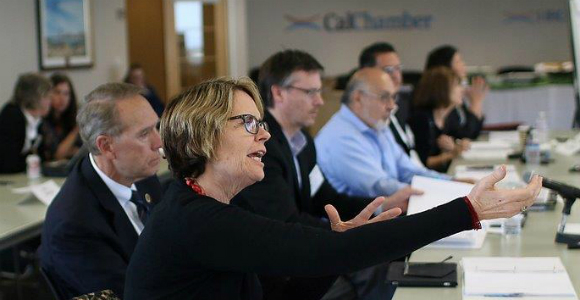Campaign to combat stigma of career tech jobs needed says task force

To get a larger slice of Californians into good-paying, long-term jobs, there needs to be a public campaign to combat the stigma of middle-skill jobs and to “show the money” in going that route. That was just one big takeaway readily apparent when a task force on upgrading California’s workforce meet for a second time yesterday.
“So, instead of just talking about going to college…let’s talk about careers and how you would get there whatever the level of education that you would need and, when they finish a level, then let’s introduce them to the next level,” said Mollie Smith, director of occupational & noncredit programs at Palomar College.
Smith is a member of the task force created by the California Community Colleges Board of Governors to brainstorm recommendations on training the more than one million middle-skill workers who will be needed in the next decade. In their second gathering, the Task Force on Workforce, Job Creation and a Strong Economy got to sharpening their ideas for closing the skills gap in the state via the workforce training programs of the 112-school system of community colleges.
As with the first meeting in January, the focus was on ways to improve the career technical education (CTE) programs offered in California and better connect them with industry needs. The discussion at several times echoed the CTE image problem brought up by employers at a recent Sacramento workforce town hall.
“But I think one of the issues is just the stigma that people assume that CTE means welding,” said Kathy Booth, WestEd‘s senior research associate, who made a presentation about workforce data and career training outcomes. “They’re not realizing that there’s–first of all, welding’s a great career–but there’s many many different pathways that they could take.”
The task force members broke into workgroups to refine recommendations on how to better define career pathways for students and how to restructure curriculum more quickly. Ideas included getting more students to have more “real world” experiences in a workplace and to better inform students and parents about the economic value of CTE programs.
“I think the salary data is very, very compelling and very powerful,” said Michael Dozier, executive director of community and economic development at California State University, Fresno. “Looking at that and saying ‘Oh if I have a high school diploma and no degree I’m going to make $20,000 and if I’ve got a certificate and I’m going to make $60,000,'” it pretty much makes me want to stay in school.”
Better understanding the value of training programs became another focus for the task force, as the group shifted to how to gather and share student and workforce data. Because of increasing pressure at state and federal level, financially and otherwise, there’s been a need to look toward longer term outcomes. And that data will be key to decisions made by educators planning curricula and by the students looking for a career.
“I think it’s frustrating for students if they go through all this education and then there’s nothing waiting for them at the end or they have to move or they have to change their whole lifestyle to get the job that they wanted or that they just trained for,” said Toni Parsons, faculty member and curriculum committee chair at San Diego Mesa College. “So I think that data–are the jobs there, what are the wages, are they in my area, are they here or do I have to go somewhere else–I think that information for the student is just as important as it is for me as a faculty member when I’m designing programs.”
One big challenge for schools designing workforce training has been having the right data, including having labor market data that aligns with what industry will need in the near future. One idea from the workgroups was to let industry partners validate labor market data to make sure not only are there enough workers but workers with the specific skills needed.
Also, task force members repeatedly underscored the need for data to be simplified, clear and understandable to everyone, especially if the goal is to encourage more young people to get into CTE fields.
“We don’t have young people that understand those opportunities,” said Jim Mayer, president and CEO of California Forward. “We don’t have parents encouraging them. We don’t have employers that are making their needs known. So, data is going to connect the skills and the outreach is going to connect people’s ambitions with their actions.”
Additionally, the task force is tackling the problem of CTE training goals and outcomes not being aligned across the college system. Several members stressed the need for initiatives for timely data sharing across the schools and with industry, and funding to keep the sharing going long term.
The fact that the discussion of economic value of training programs is being had on a statewide level is significant, especially as the problem of workforce readiness was repeatedly elevated as a priority since the beginning of the California Economic Summit in every region. The goals of the discussion will be to make sure there’s a good return on investment for everyone involved and that students are actually securing good-paying jobs in the long run.
“So it’s this shift, moving from what is it that an institution did–how many pieces of paper did you hand out–to what do students ultimately get that is the shift in perspective that is already rolling the California Community College system,” said Booth.
The task force will meet again on May 13 in Sacramento and continue refining recommendations for improving the Colleges’ workforce training and, finally, present them to the Board of Governors later this year. For many on the team, success will mean more students knowing there are many lucrative options beyond getting a traditional four-year degree.
“This whole movement is sort of bringing to the fore that ‘Oh wow, there’s this whole other arm,'” said Lynn Shaw, faculty and president of Long Beach City College Full Time Faculty Union. “For me, I live and breathe it, but I think that it needs more attention and students need to know.”
Originally published on CAeconomy.org.

Dr. Ansari on health care’s future amid demographic shifts
Original story on permanente.org During a recent CEO workgroup panel, “Advancing Your Culture…
December 23, 2024
Drs. Hoberman and Nguyen on preparing for health care AI
Original story on permanente.org Many questions surround the advancements of artificial intelligence in…
October 30, 2024